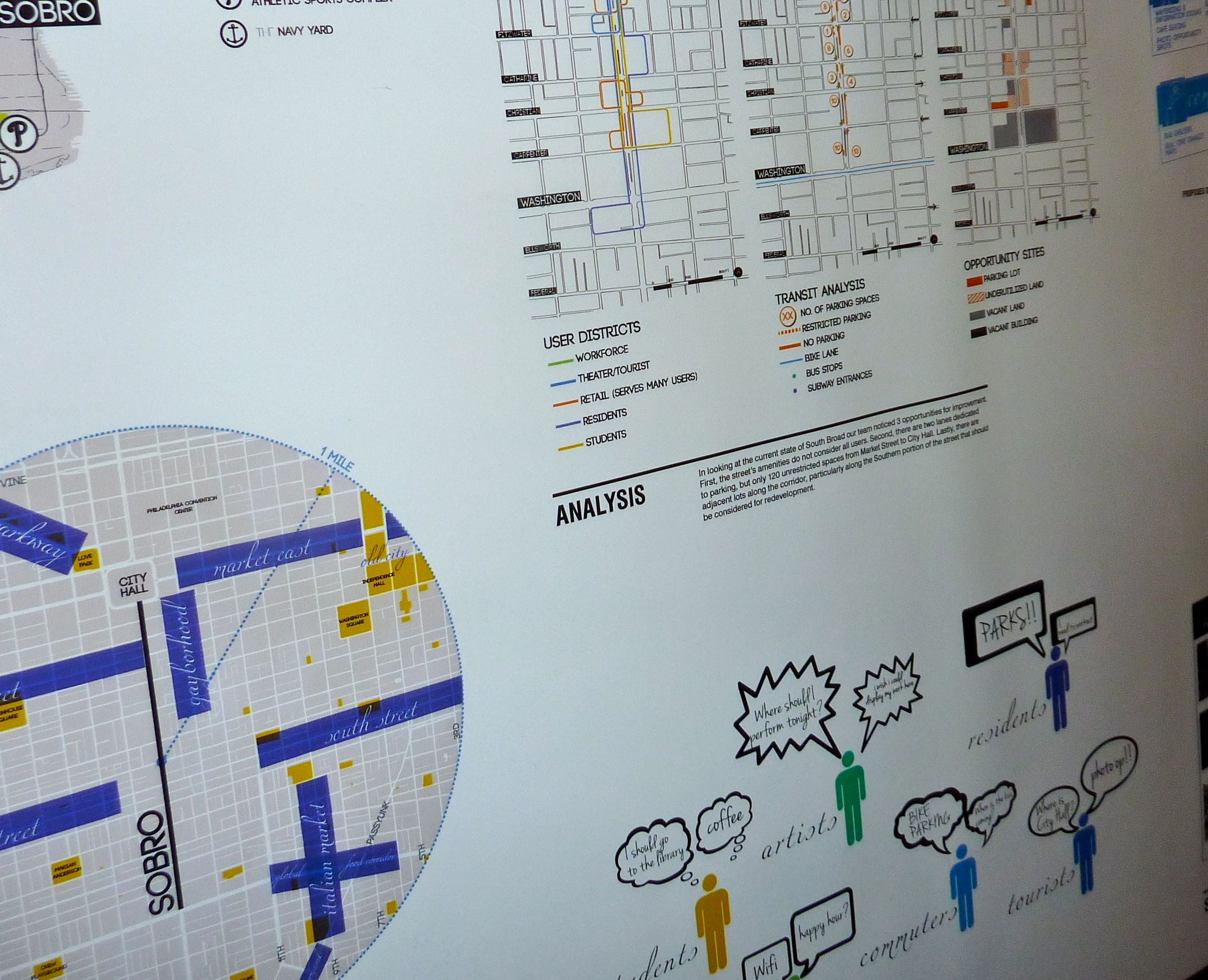Four shots at pumping more life onto South Broad Street
To celebrate its upcoming 20th anniversary, Avenue of the Arts, Inc. (AAI) recently partnered with the Pennsylvania Horticultural Society (PHS) in soliciting proposals from area designers on how to liven up South Broad Street. It’s an issue that continues to puzzle many — why arguably our most mixed-use street (it’s got everything– residents, offices, restaurants, stores, theaters, a university, and several hotels) seldom achieves the vitality that it so promises.
Ten firms rose to the challenge and four finalists were selected by AAI’s South Broad Street Task Force. Last Thursday night, PlanPhilly joined a very large crowd to preview their visions.
Thanks to a $20,000 donation from developer Carl Dranoff, each of the four spent time studying the target area (from from City Hall to Washington Avenue) and drafting conceptual drawings that focus on its streetscape. They were provided with no budgetary or other limitations — but, as far as we could tell, ideas for actual buildings do not appear to have been part of the brief.
The four plans will be on view to the general public in the lobby of the Bellevue, at Broad and Walnut Streets, through Wednesday, Nov. 14. A winning design will be announced on Nov. 19, chosen by a panel of judges that includes Dranoff, Sean Buffington, president of the University of the Arts, Deputy Mayor Alan Greenberger, Drew Becher, PHS president, and Paul Levy of the Center City District.
The plans on display will also each include a QR code so citizens can weigh in digitally with their favorites.
Here’s a brief look at the four proposals and our initial responses.
Park It Up. Architects Bohlin Cywinski Jackson are dreaming big, with an ambitious plan that includes a bridge over Washington Ave., sculpture gardens (a rather hopeful Calder stabile is pictured in the drawing), sidewalk widening, an adaptive reuse of the old train depot on Carpenter Street, and, count ’em, at least half a dozen pocket parks. You’ll find no bigger fan of pocket parks than I, but is turning empty lots into more formalized open space the highest and best use for them? (A sculpture garden is a great idea, though!) And while the avenue desperately needs a terminated vista at its southern end, I’m not sure that a bridge is the right answer.
Mix It Up. At Cairone & Kaupp, landscape architect Michael A. DeGregorio says the firm began by considering the “workers, commuters, residents, tourists, and students” that the street draws and whose needs, he says, “it doesn’t often serve.” Since South Broad Street — or SOBRO, as they’ve dubbed it — only offers 102 parking spaces along its two miles of curbs, the firm proposes to get rid of them. (Studies show, DeGregorio adds, that the daily traffic on the strip is about 13,000 cars a day and that even with reduced lanes it could accommodate up to 20,000 without any deleterious effect.) The firm suggests converting the parking lanes to everything from dog parks to play structures, from coffee stops to way-finding kiosks. Cars seldom have a place in the city, so this one speaks to me. I’m no traffic engineer, but the numbers and rationale make sense, as does offering pedestrians amenities that directly relate to their unmet needs.
Jazz It Up. Landscape Architects LRSLA Studio offers the most modest of proposals by advocating that the city hire a cultural curator who will be charged with filling vacant indoor and outdoor spaces with performing artists and the works of visual artists. According to principal, Karen Skafte, the designers imagine a “kit of parts that will allow temporary inhabitation of the street in different ways,” and includes bleachers, canopies, and something it calls a ‘flexbox,’ similar to a kiosk. At Lombard Street and Washington Avenue, it posits adding two bigger park areas. It might be expecting too much of street arts to automatically enliven big public spaces, though. They’re the pepper and spice of an already-vibrant olio, not the meat and potatoes.
Do It Now. Jonathan Alderson, principal, at Jonathan Alderson Landscape Architects, Inc. says his governing mandate for the proposal was to offer “practical and do-able ideas that can be accomplished reasonably quickly and cheaply.” His plan includes the use of moveable planters to adorn the sad Broad Street median, projectors mounted on vans that will aim images on the strip’s buildings, pop-up performance spaces, and the addition of pedestrian-centric lighting on its lamp poles. “We’re really looking at turning the street into a canvas,” he says. Further enhancements down the line, include green roofs “on everything” and community-built green spaces. His images are striking and imaginative, but the Avenue has experimented with a myriad of planting and lighting schemes over the years, to varying degrees of success. At this point, it will be hard to convince anyone that they provide enough of an answer.
Contact the reporter at jgreco@planphilly.com and follow her on Twitter @joanngreco
WHYY is your source for fact-based, in-depth journalism and information. As a nonprofit organization, we rely on financial support from readers like you. Please give today.







